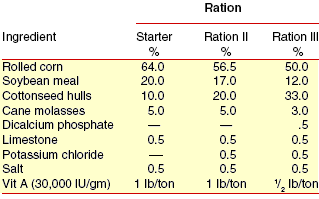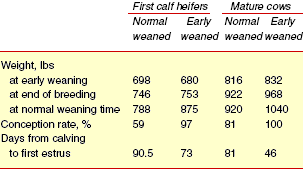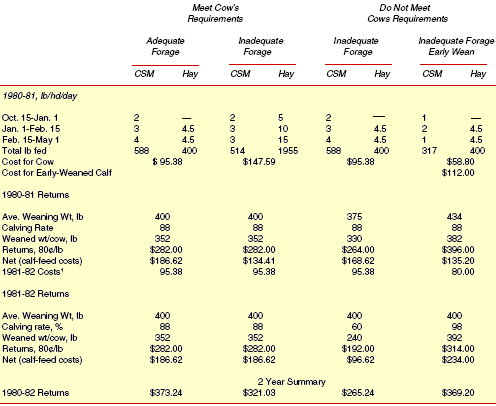



Early weaning for the beef herd
By David Lalman, Assistant Professor Beef Cattle, Oklahoma Cooperative Extension. Early weaning of calves at 6 to 8 weeks of age is an effective way to get high rebreeding rates even in very thin cows. Although, early weaning is certainly not advocated for all producers all of the time, it can provide an attractive alternative in certain situations such as drought, when large amounts of purchased forage would be necessary to maintain a cow herd through to normal weaning time or when cows are already too thin to rebreed. Studies at Oklahoma State University show that early-weaned calves can be efficiently raised to a normal weaning weight with minimal labor and facilities.
Early weaning of calves at 6 to 8 weeks of age is an effective way to get high rebreeding rates even in very thin cows. Although, early weaning is certainly not advocated for all producers all of the time, it can provide an attractive alternative in certain situations such as drought, when large amounts of purchased forage would be necessary to maintain a cow herd through to normal weaning time or when cows are already too thin to rebreed. Studies at Oklahoma State University show that early-weaned calves can be efficiently raised to a normal weaning weight with minimal labor and facilities.
Why Early Weaning Works
Lactation roughly doubles the daily energy and protein requirement for a typical beef cow. Removing the calf at six to eight weeks into lactation obviously reduces the quantity and quality of forage needed to maintain the cow herd. Reasons for improved rebreeding after early weaning involve more than nutrition, however. Research has shown that the removal of the nursing calf causes hormonal changes in the cows that stimulate estrus. Estrus activity can then be induced in cows too thin to cycle while still suckling a calf.Age for Early Weaning
In order to maintain a 365-day calving interval, calves should be early weaned at less than 80 days of age. About 40 days of age may be a practical minimum for early weaning in beef herds. Calves at least 40 days old do not require milk replacers in the ration and are old enough to eat dry feed. Since smaller and younger calves may have difficulty competing for feed and water, the age range in any given group of early-weaned calves should be kept as narrow as possible.Managing the Early Weaned Calf
The procedures described in this fact sheet were developed from two studies conducted at the Range Cow Research Center at OSU. A total of 54 calves were early weaned in both studies. The most critical time is the first two weeks after early weaning. Calves must overcome the stress of weaning and learn to eat dry feed very quickly. The first ration should be very palatable and high in protein and energy, since the total ration consumption will at first be small. Creep feeding in the pasture prior to early weaning would be helpful; however, 6- 8 week old calves don’t generally eat much creep while still nursing on the cow.At the time of early weaning, all calves should be vaccinated for blackleg and malignant edema. Consult a local veterinarian for other suggested vaccinations. All calves not intended for breeding replacements should be implanted.
The calves should be placed in a small pen with some type of shelter available. The feed bunk and water source should be easily accessible and recognizable. A starter ration that has worked well is shown in Table 1. It is high in both energy and protein. Cottonseed hulls are used as the sole roughage source, since they are extremely palatable. If chopped hay is substituted for cottonseed hulls, molasses should be added to minimize dust. Avoid alfalfa pellets, because calves tend to sort them from the concentrate portion of the ration, a problem that can lead to founder if too much concentrate is eaten. Soybean meal is preferred over cottonseed meal for young calves.
Calves should be hand fed the starter ration until consumption reaches 4-5 lbs/head/day. This normally takes 10- 14 days. To insure that smaller and more timid calves get a chance at feed and water, limit 20 calves per pen during the critical first few days on thc starter ration. Placing one or two older calves that are accustomed to eating and drinking in with the early-weaned calves helps to reduce stress on the weaned calves. Observations at OSU have indicated that the newly weaned calves tend to follow the older calves to the feed bunk and waterers.
Table 1. Early Weaning Rations

After 10-14 days on the starter ration, the early weaned calves can be moved to a larger pen and switched to Ration II fed in a self-feeder. Ration II should be fed for about six weeks or until the first sign of scours. At this time, Ration III should be fed until normal weaning age. If coccidiosis is felt to be a potential problem, a cocciostat should be fed at the start of the early weaning period.
Problems to look for during the drylot rearing of the calves are: 1) respiratory problems, especially during the first few days; 2) sorting of the ration, which can lead to founder; 3) coccidiosis and 4) scouring. Remember that early-weaned calves are started with a ration high in energy and protein and are gradually changed to a grower-type ration as their total intake increases.
Expected Calf Performance
Daily gains of commercial Hereford and Hereford x Angus calves have averaged about 1.75 lbs/day from 6-8 weeks of age to 205 days of age. These calves consumed about 9 lbs of feed during the early weaning period, with a feed conversion of 4.5 lbs of dry matter per pound of gain. Weaning weights (205-day steer equivalent) for early weaned calves were 435 lbs, compared to 347 lbs for calves raised by their dams on summer bermuda pasture. The calves weighed an average of 155 lbs at the time of early weaning. Performance of early-weaned calves compared to pasture reared calves will depend on the growth potential of the calves, the level of milk production of the dams and the level of management.In order to reduce feed purchases, many producers may wish to move early-weaned calves to pasture after the calves have reached an average weight of 250-300 lbs in drylot. OSU research indicates that gains of early-weaned calves run on native pasture from late July (with grain supplementation) were lower than for calves raised completely in drylot. High quality forage such as wheat pasture will likely be required to get good gains on lightweight, early-weaned calves.
All roughage fed to early-weaned calves should be mixed in desired portions in a complete ration. When free-choice hay is available, some calves may consume mostly hay, which provides protein, minerals and energy. By increasing the roughage level of the complete rations as the calves get bigger and thus increasing their daily ration intake, the correct levels of protein, energy and minerals can be “metered” into the calves.
Expected Improvements in Cow Performance
Table 2 shows weight gain and rebreeding improvements for first calf Hereford heifers and mature cows that had their calves early weaned at 6 to 8 weeds of age. Early weaning increased conception rates of very thin first-calf heifers from 50% to 97% and shortened the days to first estrus by 17 days. The mature cows were judged to be in moderate condition. All the early weaned cows rebred, while only 81% of the cows that raised calves rebred. Many of the cows cycled within three days of early weaning; indicating that extra bull power may be needed for a few days following early weaning.As expected, heifers and cows whose calves were weaned early were heavier at normal weighing time than were those cows and heifers that raised calves. Since these cows are in better condition, they will require less supplemental feed during the following winter. This factor will need to be considered in the budgeting of an early weaning program.
Table 2. Effects of early weaning on cow and heifer performance

An economic analysis of early weaning is shown in Table 3. A spring calving program on native range or bermuda is used in which calving begins about February 15. An 88% calf crop with 400 lb weaning weights is considered average for cows raising their calves. Rations I, II and III are priced at $186, $175, and $159/ton respectively, which includes a $20/ ton markup. The ingredient prices used to arrive at the ration costs are shown at the bottom of Table 3.
The feasibility of early weaning is evaluated under four situations:
- There is adequate standing roughage and the cow’s nutrient requirements can be met with cottonseed meal. Supplemental hay will be fed only during periods when ice and snow covers forage.
- Standing roughage is in short supply, and grass hay will be fed along with cottonseed meal to meet the cow’s nutrient requirements.
- There is inadequate standing roughage, but the hay supply is inadequate to meet the cow’s requirements. Cows will be in poor condition at breeding in the spring of 1981.
- Same as 3, but we will early-wean at 6-8 weeks of age in the spring of 1981.
Note that for 1981, early weaning about breaks even with purchasing grass hay in situations where forage is scarce. Assuming a 98% calf crop the following year from earlyweaned cows, along with their lower wintering cost, early weaning shows a $48 advantage for the two-year period over purchasing hay in 1980-81. Early weaning netted a $104 advantage over living through poor conception rates with underfed cows.
The most likely place for early weaning is in a situation where poor conception rates are expected. Depending on concentrate and hay prices, early weaning might be profitable when large amounts of hay must be purchased for the cows. Producers should substitute their own feed costs as appropriate in this budget.
Table 3. Costs and return analysis for early weaning vs. normal weaning of calves born in February of 1981; The impact on returns for 1981 and 1982.

Summary
Calves can be successfully weaned at 6 to 8 weeks of age and efficiently raised to a normal weaning weight in drylot. Early weaning will permit high conception rates and rapid rebreeding. While early weaning is certainly not recommended as standard practice, it should be useful in times of droughtwhen purchased feed may be more efficiently fed directly to thc calf than to thc lactating cow. Early weaning may also offer cattlemen a chance to achieve high conception rates in cows to thin to rebreed otherwise.December 2003


